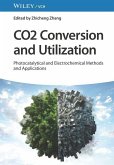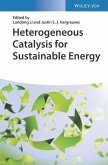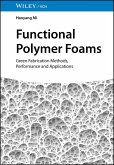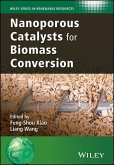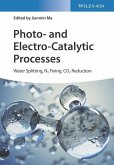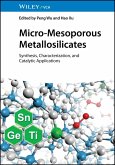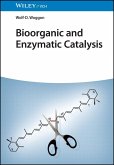- Gebundenes Buch
- Merkliste
- Auf die Merkliste
- Bewerten Bewerten
- Teilen
- Produkt teilen
- Produkterinnerung
- Produkterinnerung
An invaluable resource for all those working in catalysis, green chemistry, and advanced synthetic methods related to ionic liquids.
Andere Kunden interessierten sich auch für
![CO2 Conversion and Utilization CO2 Conversion and Utilization]() CO2 Conversion and Utilization105,99 €
CO2 Conversion and Utilization105,99 €![Heterogeneous Catalysis for Sustainable Energy Heterogeneous Catalysis for Sustainable Energy]() Heterogeneous Catalysis for Sustainable Energy126,99 €
Heterogeneous Catalysis for Sustainable Energy126,99 €![Functional Polymer Foams Functional Polymer Foams]() Haoyang MiFunctional Polymer Foams104,99 €
Haoyang MiFunctional Polymer Foams104,99 €![Nanoporous Catalysts for Biomass Conversion Nanoporous Catalysts for Biomass Conversion]() Nanoporous Catalysts for Biomass Conversion149,99 €
Nanoporous Catalysts for Biomass Conversion149,99 €![Photo- and Electro-Catalytic Processes Photo- and Electro-Catalytic Processes]() Photo- and Electro-Catalytic Processes199,00 €
Photo- and Electro-Catalytic Processes199,00 €![Micro-Mesoporous Metallosilicates Micro-Mesoporous Metallosilicates]() Micro-Mesoporous Metallosilicates112,99 €
Micro-Mesoporous Metallosilicates112,99 €![Bioorganic and Enzymatic Catalysis Bioorganic and Enzymatic Catalysis]() Wolf-D. WoggonBioorganic and Enzymatic Catalysis106,99 €
Wolf-D. WoggonBioorganic and Enzymatic Catalysis106,99 €-
-
-
An invaluable resource for all those working in catalysis, green chemistry, and advanced synthetic methods related to ionic liquids.
Produktdetails
- Produktdetails
- Verlag: Wiley-VCH
- Artikelnr. des Verlages: 1135075 000
- 1. Auflage
- Seitenzahl: 384
- Erscheinungstermin: April 2025
- Englisch
- Abmessung: 248mm x 175mm x 26mm
- Gewicht: 666g
- ISBN-13: 9783527350759
- ISBN-10: 3527350756
- Artikelnr.: 71538774
- Herstellerkennzeichnung
- Wiley-VCH GmbH
- Boschstraße 12
- 69469 Weinheim
- wiley.buha@zeitfracht.de
- Verlag: Wiley-VCH
- Artikelnr. des Verlages: 1135075 000
- 1. Auflage
- Seitenzahl: 384
- Erscheinungstermin: April 2025
- Englisch
- Abmessung: 248mm x 175mm x 26mm
- Gewicht: 666g
- ISBN-13: 9783527350759
- ISBN-10: 3527350756
- Artikelnr.: 71538774
- Herstellerkennzeichnung
- Wiley-VCH GmbH
- Boschstraße 12
- 69469 Weinheim
- wiley.buha@zeitfracht.de
Zhimin Liu is a group leader of Institute of Chemistry, Chinese Academy of Sciences (ICCAS), China. Having obtained her Ph D. degree from China Petroleum University and worked as a postdoc in ICCAS, she spent most of her career working in ICCAS before taking up her present appointment at ICCAS. Professor Liu has authored over 300 scientific publications and has received numerous scientific awards, including National Natural Scientific Awards of China (Second class). She is an Editor-in-Chief of Current Opinion in Green and Sustainable Chemistry.
Chapter 1 Ionic liquid catalysts
1.1 Acidic ionic liquids
1.2 Basic ionic liquids
1.3 Neutra ionic liquids with hydrogen-bond donor/acceptor
1.4 Chiral ionic liquids
Chapter 2 Ionic liquid-catalyzed transformation of carbon dioxide to chemicals under metal-free conditions
2.1 Synthesis of organic carbonates
2.2 Synthesis of N-containing heterocycles
2.3 Reductive transformation of CO2
2.4 Synthesis of other compounds
2.5 Remarks and perspectives
Chapter 3 Ionic liquid-mediated reductive transformation of carbon dioxide with hydrogen
3.1 Direct hydrogenation of CO2
3.2 N-formylated or N-methylated reaction of amines with CO2/H2
3.3 Hydroformylation of olefin with CO2/H2
3.4 Hydromethylamination of olefin with CO2/H2 and amines
3.5 Carbonylation of alcohol/ethers with CO2/H2
3.6 Remarks and perspectives
Chapter 4 Electrochemical reduction of carbon dioxide in ionic liquid-based electrolytes
4.1 Fundamentals of CO2 electroreduction
4.2 Ionic liquid-based electrolytes for CO2 electroreduction
4.3 Electroreduction of CO2 to various chemicals in IL-based electrolytes
4.4 Electro-transformation of CO2 into value-added chemicals
4.5 Remarks and perspectives
Chapter 5 Ionic liquid-catalyzed chemical transformation of lignocellulose
5.1 Ionic liquid-catalyzed transformation of cellulose and its derivatives
5.2 Ionic liquid-catalyzed transformation of hemicellulose and xylose to furfural
5.3 Ionic liquid-catalyzed transformation of lignin and its platforms
5.4 Remarks and perspectives
Chapter 6 Ionic liquid catalyzed oxidation reactions
6.1 Oxidation of alcohols/aldehydes
6.2 Oxidation of organic sulfides and oxidative desulfurization
6.3 Oxidative cyclization of olefins and allylic alcohols
6.4 Oxidation of amines
6.5 Baeyer-Villiger oxidation
6.6 Oxidation of other compounds
6.7 Remarks and perspectives
Chapter 7 Ionic liquid catalyzed water-involved reactions
7.1 Dehydrative esterification
7.2 Dehydrative etherification of alcohols
7.3 Dehydration alkenylation
7.4 Dehydrative amidation
7.5 Ionic liquid catalyzed hydration reaction
7.6 Hydrolysis of esters/ ethers
7.7 Remarks and perspectives
Chapter 8 Ionic liquid-catalyzed other organic reactions
8.1 Alkylation reaction
8.2 Michael addition reaction
8.3 Diels-Alder reactions
8.4 Markovnikov addition
8.5 Knoevenagel condensation
8.6 Aldol condensation reaction
8.7 Ring-closing C-O/C-O and C-O/O-H bond metathesis
8.8 Remarks and perspectives
Chapter 9 Ionic liquid catalyzed recycling of spent polymers
9.1 Degradation of polyesters 1
9.2 Degradation of polyamides
9.3 Upcycling of polyolefins
9.4 Co-upcycling of PVC and polyester
9.5 Remarks and perspectives
Acknowledgements
1.1 Acidic ionic liquids
1.2 Basic ionic liquids
1.3 Neutra ionic liquids with hydrogen-bond donor/acceptor
1.4 Chiral ionic liquids
Chapter 2 Ionic liquid-catalyzed transformation of carbon dioxide to chemicals under metal-free conditions
2.1 Synthesis of organic carbonates
2.2 Synthesis of N-containing heterocycles
2.3 Reductive transformation of CO2
2.4 Synthesis of other compounds
2.5 Remarks and perspectives
Chapter 3 Ionic liquid-mediated reductive transformation of carbon dioxide with hydrogen
3.1 Direct hydrogenation of CO2
3.2 N-formylated or N-methylated reaction of amines with CO2/H2
3.3 Hydroformylation of olefin with CO2/H2
3.4 Hydromethylamination of olefin with CO2/H2 and amines
3.5 Carbonylation of alcohol/ethers with CO2/H2
3.6 Remarks and perspectives
Chapter 4 Electrochemical reduction of carbon dioxide in ionic liquid-based electrolytes
4.1 Fundamentals of CO2 electroreduction
4.2 Ionic liquid-based electrolytes for CO2 electroreduction
4.3 Electroreduction of CO2 to various chemicals in IL-based electrolytes
4.4 Electro-transformation of CO2 into value-added chemicals
4.5 Remarks and perspectives
Chapter 5 Ionic liquid-catalyzed chemical transformation of lignocellulose
5.1 Ionic liquid-catalyzed transformation of cellulose and its derivatives
5.2 Ionic liquid-catalyzed transformation of hemicellulose and xylose to furfural
5.3 Ionic liquid-catalyzed transformation of lignin and its platforms
5.4 Remarks and perspectives
Chapter 6 Ionic liquid catalyzed oxidation reactions
6.1 Oxidation of alcohols/aldehydes
6.2 Oxidation of organic sulfides and oxidative desulfurization
6.3 Oxidative cyclization of olefins and allylic alcohols
6.4 Oxidation of amines
6.5 Baeyer-Villiger oxidation
6.6 Oxidation of other compounds
6.7 Remarks and perspectives
Chapter 7 Ionic liquid catalyzed water-involved reactions
7.1 Dehydrative esterification
7.2 Dehydrative etherification of alcohols
7.3 Dehydration alkenylation
7.4 Dehydrative amidation
7.5 Ionic liquid catalyzed hydration reaction
7.6 Hydrolysis of esters/ ethers
7.7 Remarks and perspectives
Chapter 8 Ionic liquid-catalyzed other organic reactions
8.1 Alkylation reaction
8.2 Michael addition reaction
8.3 Diels-Alder reactions
8.4 Markovnikov addition
8.5 Knoevenagel condensation
8.6 Aldol condensation reaction
8.7 Ring-closing C-O/C-O and C-O/O-H bond metathesis
8.8 Remarks and perspectives
Chapter 9 Ionic liquid catalyzed recycling of spent polymers
9.1 Degradation of polyesters 1
9.2 Degradation of polyamides
9.3 Upcycling of polyolefins
9.4 Co-upcycling of PVC and polyester
9.5 Remarks and perspectives
Acknowledgements
Chapter 1 Ionic liquid catalysts
1.1 Acidic ionic liquids
1.2 Basic ionic liquids
1.3 Neutra ionic liquids with hydrogen-bond donor/acceptor
1.4 Chiral ionic liquids
Chapter 2 Ionic liquid-catalyzed transformation of carbon dioxide to chemicals under metal-free conditions
2.1 Synthesis of organic carbonates
2.2 Synthesis of N-containing heterocycles
2.3 Reductive transformation of CO2
2.4 Synthesis of other compounds
2.5 Remarks and perspectives
Chapter 3 Ionic liquid-mediated reductive transformation of carbon dioxide with hydrogen
3.1 Direct hydrogenation of CO2
3.2 N-formylated or N-methylated reaction of amines with CO2/H2
3.3 Hydroformylation of olefin with CO2/H2
3.4 Hydromethylamination of olefin with CO2/H2 and amines
3.5 Carbonylation of alcohol/ethers with CO2/H2
3.6 Remarks and perspectives
Chapter 4 Electrochemical reduction of carbon dioxide in ionic liquid-based electrolytes
4.1 Fundamentals of CO2 electroreduction
4.2 Ionic liquid-based electrolytes for CO2 electroreduction
4.3 Electroreduction of CO2 to various chemicals in IL-based electrolytes
4.4 Electro-transformation of CO2 into value-added chemicals
4.5 Remarks and perspectives
Chapter 5 Ionic liquid-catalyzed chemical transformation of lignocellulose
5.1 Ionic liquid-catalyzed transformation of cellulose and its derivatives
5.2 Ionic liquid-catalyzed transformation of hemicellulose and xylose to furfural
5.3 Ionic liquid-catalyzed transformation of lignin and its platforms
5.4 Remarks and perspectives
Chapter 6 Ionic liquid catalyzed oxidation reactions
6.1 Oxidation of alcohols/aldehydes
6.2 Oxidation of organic sulfides and oxidative desulfurization
6.3 Oxidative cyclization of olefins and allylic alcohols
6.4 Oxidation of amines
6.5 Baeyer-Villiger oxidation
6.6 Oxidation of other compounds
6.7 Remarks and perspectives
Chapter 7 Ionic liquid catalyzed water-involved reactions
7.1 Dehydrative esterification
7.2 Dehydrative etherification of alcohols
7.3 Dehydration alkenylation
7.4 Dehydrative amidation
7.5 Ionic liquid catalyzed hydration reaction
7.6 Hydrolysis of esters/ ethers
7.7 Remarks and perspectives
Chapter 8 Ionic liquid-catalyzed other organic reactions
8.1 Alkylation reaction
8.2 Michael addition reaction
8.3 Diels-Alder reactions
8.4 Markovnikov addition
8.5 Knoevenagel condensation
8.6 Aldol condensation reaction
8.7 Ring-closing C-O/C-O and C-O/O-H bond metathesis
8.8 Remarks and perspectives
Chapter 9 Ionic liquid catalyzed recycling of spent polymers
9.1 Degradation of polyesters 1
9.2 Degradation of polyamides
9.3 Upcycling of polyolefins
9.4 Co-upcycling of PVC and polyester
9.5 Remarks and perspectives
Acknowledgements
1.1 Acidic ionic liquids
1.2 Basic ionic liquids
1.3 Neutra ionic liquids with hydrogen-bond donor/acceptor
1.4 Chiral ionic liquids
Chapter 2 Ionic liquid-catalyzed transformation of carbon dioxide to chemicals under metal-free conditions
2.1 Synthesis of organic carbonates
2.2 Synthesis of N-containing heterocycles
2.3 Reductive transformation of CO2
2.4 Synthesis of other compounds
2.5 Remarks and perspectives
Chapter 3 Ionic liquid-mediated reductive transformation of carbon dioxide with hydrogen
3.1 Direct hydrogenation of CO2
3.2 N-formylated or N-methylated reaction of amines with CO2/H2
3.3 Hydroformylation of olefin with CO2/H2
3.4 Hydromethylamination of olefin with CO2/H2 and amines
3.5 Carbonylation of alcohol/ethers with CO2/H2
3.6 Remarks and perspectives
Chapter 4 Electrochemical reduction of carbon dioxide in ionic liquid-based electrolytes
4.1 Fundamentals of CO2 electroreduction
4.2 Ionic liquid-based electrolytes for CO2 electroreduction
4.3 Electroreduction of CO2 to various chemicals in IL-based electrolytes
4.4 Electro-transformation of CO2 into value-added chemicals
4.5 Remarks and perspectives
Chapter 5 Ionic liquid-catalyzed chemical transformation of lignocellulose
5.1 Ionic liquid-catalyzed transformation of cellulose and its derivatives
5.2 Ionic liquid-catalyzed transformation of hemicellulose and xylose to furfural
5.3 Ionic liquid-catalyzed transformation of lignin and its platforms
5.4 Remarks and perspectives
Chapter 6 Ionic liquid catalyzed oxidation reactions
6.1 Oxidation of alcohols/aldehydes
6.2 Oxidation of organic sulfides and oxidative desulfurization
6.3 Oxidative cyclization of olefins and allylic alcohols
6.4 Oxidation of amines
6.5 Baeyer-Villiger oxidation
6.6 Oxidation of other compounds
6.7 Remarks and perspectives
Chapter 7 Ionic liquid catalyzed water-involved reactions
7.1 Dehydrative esterification
7.2 Dehydrative etherification of alcohols
7.3 Dehydration alkenylation
7.4 Dehydrative amidation
7.5 Ionic liquid catalyzed hydration reaction
7.6 Hydrolysis of esters/ ethers
7.7 Remarks and perspectives
Chapter 8 Ionic liquid-catalyzed other organic reactions
8.1 Alkylation reaction
8.2 Michael addition reaction
8.3 Diels-Alder reactions
8.4 Markovnikov addition
8.5 Knoevenagel condensation
8.6 Aldol condensation reaction
8.7 Ring-closing C-O/C-O and C-O/O-H bond metathesis
8.8 Remarks and perspectives
Chapter 9 Ionic liquid catalyzed recycling of spent polymers
9.1 Degradation of polyesters 1
9.2 Degradation of polyamides
9.3 Upcycling of polyolefins
9.4 Co-upcycling of PVC and polyester
9.5 Remarks and perspectives
Acknowledgements


